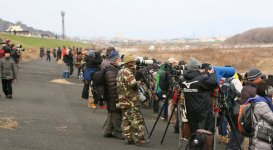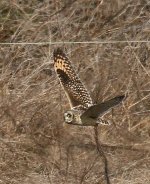The RSPB has a map of the UK distribution of Short-eared Owls
here.
This year, in Osaka, Japan, at a piece of scrubland along the river right in the city, there was a group of 12 Short-eared Owls that came for the winter. There was a lot of interest. Photo 1: looking right. Photo 2: looking left (the twelve owls spread out which was thoughtful of them).
We went twice (about 90 minutes each way). At least a few of the owls could always be seen sitting around, so the time wasn't wasted, but they didn't always fly when the light was good enough for sighting.
The first time we went, the owls didn't fly at all before darkness. The second time two owls flew for a total of about thirty seconds at around 3:30, so we all got optimistic. But they didn't fly again before dusk. Presumably, when breeding they would be a lot more active.
As you can see from the photos, there were a lot of people, but the owls seemed to be cool about that. Some people went almost every day for six months, and got some great photos (e.g. pairs of birds flying, one from the back, one from the front, in the snow), but spending half a daylight year in a place like this for just a few photos is not my idea of fun.








